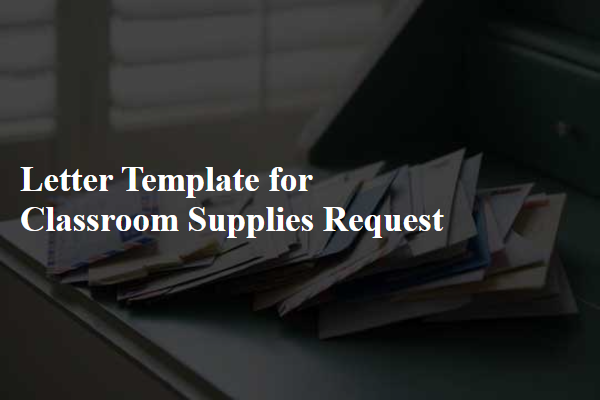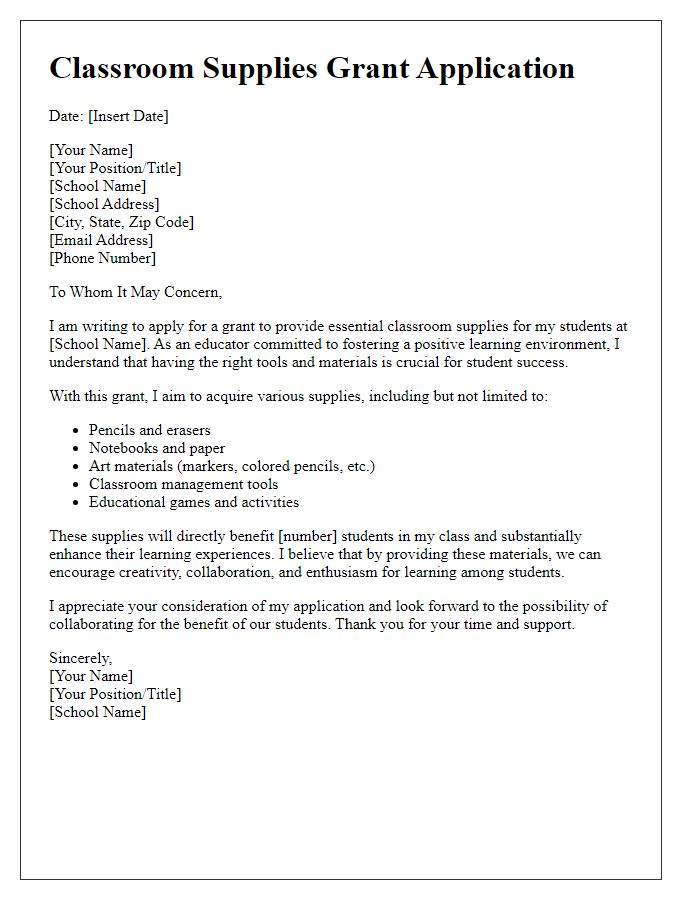Are you tired of running low on classroom supplies right when you need them most? We know how challenging it can be to keep everything stocked while maintaining a productive learning environment. In this article, we'll guide you through a practical letter template to help you request supplies, ensuring your students have the tools they need to succeed. So, let's dive in and discover how you can effectively communicate your needs!

Subject Line Optimization
Subject lines play a crucial role in capturing attention and conveying the purpose of a message effectively. A well-optimized subject line for a classroom supplies request might include specific details such as the type of supplies needed, the intended use, and any relevant deadlines. For instance, "Request for Art Supplies: Glitter, Paint, and Brushes Needed by May 1st for Student Project." This subject line specifies the supplies (art materials), clarifies their purpose (for a student project), and includes a deadline (May 1st) to emphasize urgency. Providing clear and concise information increases the chances of a prompt response from the recipient.
Personalization and Tone
In educational settings, a well-crafted supplies request can enhance engagement among stakeholders. Teachers often seek essential materials such as notebooks (typically 100 sheets), pencils (preferably No. 2 for standardized tests), and art supplies (like acrylic paint sets with at least 12 colors) to create an enriching learning environment. Personalized details, such as the intended use of supplies for specific projects (like the upcoming science fair on November 15th) or recognizing the needs of diverse learners (including those with learning disabilities), can foster goodwill and support from parents and administrators. The tone must remain respectful and appreciative, ensuring all parties feel valued in contributing to the classroom's success.
Specific Supplies List with Justification
Classroom supplies are essential for creating an effective learning environment. A comprehensive list of required materials includes items such as notebooks (wide-ruled, 100 sheets), pens (blue and black ink), colored pencils (12-pack for art projects), dry erase markers (for interactive board sessions), and highlighters (various colors for effective note-taking). Notebooks facilitate organized note-taking during lessons, while pens are critical for written assignments and assessments. Colored pencils are important for art projects and visual aids, enhancing creativity and engagement. Dry erase markers allow for flexible teaching methods on whiteboards, essential in modern classrooms. Highlighters improve students' study techniques by helping them easily identify key information in textbooks. Adequate funding for these supplies supports improved student performance, fosters creativity, and enhances collaborative learning experiences.
Clear Call to Action
In many educational settings, teachers often face challenges in obtaining essential classroom supplies necessary for effective teaching. Items such as dry-erase markers, notebooks, and educational games play crucial roles in enhancing student engagement and learning outcomes. Schools may be hard-pressed for budgetary allocations, making requests for supplies essential. A well-structured supply request can highlight the immediate needs of the classroom. For example, in a typical school year, a classroom of 30 students might require at least 150 notebooks, ensuring each child has personal materials for taking notes, completing assignments, and participating in group activities. By clearly articulating specific needs and the positive impact on students' educational experiences, teachers can create a compelling case for securing necessary resources from administrative offices or community sponsors. Effective communication channels can further amplify the urgency and importance of fulfilling these requests, ensuring every student has access to the tools necessary for success.
Contact Information and Follow-up Plan
Classroom supply requests often arise in educational settings to ensure that students have the necessary materials for effective learning. Essential items include notebooks, pens, pencils, markers, and paper, which can significantly influence student engagement and productivity. The process to request supplies typically involves clear contact information, making it easy for school administrators to communicate with teachers or staff members regarding the request. A follow-up plan might include specific timelines for the request's fulfillment, ensuring that educators receive the materials in a timely manner to maximize their effectiveness during the school year. Schools may also establish channels through which parents and community members can contribute, fostering a collaborative environment that supports student learning.













Comments